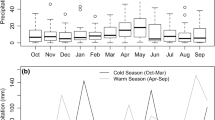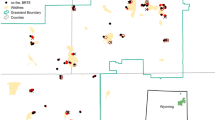Abstract
The invasive annual grass Bromus tectorum (cheatgrass) forms a positive feedback with fire in some areas of western North America’s sagebrush biome by increasing fire frequency and size, which then increases B. tectorum abundance post-fire and dramatically alters ecosystem structure and processes. However, this positive response to fire is not consistent across the sagebrush steppe. Here, we ask whether different climate conditions across the sagebrush biome can explain B. tectorum’s variable response to fire. We found that climate variables differed significantly between 18 sites where B. tectorum does and does not respond positively to fire. A positive response was most likely in areas with higher annual temperatures and lower summer precipitation. We then chose a climatically intermediate site, with intact sagebrush vegetation, to evaluate whether a positive feedback had formed between B. tectorum and fire. A chronosequence of recent fires (1–15 years) at the site created a natural replicated experiment to assess abundance of B. tectorum and native plants. B. tectorum cover did not differ between burned and unburned plots but native grass cover was higher in recently burned plots. Therefore, we found no evidence for a positive feedback between B. tectorum and fire at the study site. Our results suggest that formation of a positive B. tectorum-fire feedback depends on climate; however, other drivers such as disturbance and native plant cover are likely to further influence local responses of B. tectorum. The dependence of B. tectorum’s response to fire on climate suggests that climate change may expand B. tectorum’s role as a transformative invasive species within the sagebrush biome.





Similar content being viewed by others
References
Abatzoglou JT, Kolden CA. 2013. Relationships between climate and macroscale area burned in the western United States. Int J Wildland Fire 22:1003–20.
Anderson JE, Inouye RS. 2001. Landscape-scale changes in plant species abundance and biodiversity of a sagebrush steppe over 45 years. Ecol Monogr 71:531–56.
Antos JA, McCune B, Bara C. 1983. The effect of fire on an ungrazed western montana grassland. Am Midl Nat 110:354–64.
Bagchi S, Briske DD, Bestelmeyer BT, Wu XB. 2013. Assessing resilience and state-transition models with historical records of cheatgrass Bromus tectorum invasion in North American sagebrush-steppe. J Appl Ecol 50:1131–41.
Balch JK, Bradley BA, D’Antonio CM, Gomez-Dans J. 2013. Introduced annual grass increases regional fire activity across the arid western USA (1980–2009). Glob Change Biol 19:173–83.
Bangert R, Huntly N. 2010. The distribution of native and exotic plants in a naturally fragmented sagebrush-steppe ecosystem. Biol Invasions 12:1627–40.
Billings WD. 1994. Ecological affects of cheatgrass and resultant fire on ecosystems in the western Great Basin. In: Monsen SB, Kitchen SG, Eds. Ecology and management of annual rangelands. Ogden, UT: USDA Forest Service Intermountain Research Station. p. 22–30.
Blaisdell JP. 1953. Ecological effects of planned burning of sagebrush-grass range on the upper Snake River Plains. Washington, DC: USDA. p 39.
Blank RR, Chambers J, Roundy B, Whittaker A. 2007. Nutrient availability in rangeland soils: influence of prescribed burning, herbaceous vegetation removal, overseeding with Bromus tectorum, season, and elevation. Rangeland Ecol Manag 60:644–55.
Bradford JB, Lauenroth WK. 2006. Controls over invasion of Bromus tectorum: the importance of climate, soil, disturbance and seed availability. J Veg Sci 17:693–704.
Bradley BA. 2009. Regional analysis of the impacts of climate change on cheatgrass invasion shows potential risk and opportunity. Glob Change Biol 15:196–208.
Bradley BA, Wilcove DS. 2009. When invasive plants disappear: transformative restoration possibilities in the Western United States resulting from climate change. Restor Ecol 17:715–21.
Brooks ML, D’Antonio CM, Richardson DM, Grace JB, Keeley JE, DiTomaso JM, Hobbs RJ, Pellant M, Pyke D. 2004. Effects of invasive alien plants on fire regimes. BioScience 54:677–88.
Brummer TJ, Maxwell BD, Higgs MD, Rew LJ. 2013. Implementing and interpreting local-scale invasive species distribution models. Divers Distrib 19:919–32.
Carlevaro F, Croissant Y, Hoareau S. 2012. mhurdle: estimation of models with limited dependent variables. R package version 0.1-3.
Chambers JC, Roundy BA, Blank RR, Meyer SE, Whittaker A. 2007. What makes Great Basin sagebrush ecosystems invasible by Bromus tectorum? Ecol Monogr 77:117–45.
Christensen EM. 1964. Changes in composition of a Bromus tectorum–Sporobolus cryptandrus–Aristida longiseta community following fire. Proc Utah Acad Sci Arts Lett 41:53–7.
Condon L, Weisberg PJ, Chambers JC. 2011. Abiotic and biotic influences on Bromus tectorum invasion and Artemisia tridentata recovery after fire. Int J Wildland Fire 20:597–604.
Cook JG, Hershey TJ, Irwin LL. 1994. Vegetative response to burning on Wyoming mountain-shrub big game ranges. J Range Manag 47:296–302.
Cronquist A, Holmgren AH, Holmgren NH, Reveal JL, Holmgren PK. 1977. Intermountain Flora. Bronx, NY: New York Botanical Garden Press.
D’Antonio CM, Vitousek PM. 1992. Biological invasions by exotic grasses, the grass/fire cycle, and global change. Ann Rev Ecol Syst 23:63–87.
Daubenmire RF. 1942. An ecological study of the vegetation of Southeastern Washington and Adjacent Idaho. Ecol Monogr 12:53–79.
Davies GM, Bakker JD, Dettweiler-Robinson E, Dunwiddie PW, Hall SA, Downs J, Evans J. 2012a. Trajectories of change in sagebrush steppe vegetation communities in relation to multiple wildfires. Ecol Appl 22:1562–77.
Davies KW, Bates JD, Nafus AM. 2012b. Comparing burned and mowed treatments in Mountain Big Sagebrush Steppe. Environ Manag 50:451–61.
Davies KW, Svejcar TJ, Bates JD. 2009. Interaction of historical and nonhistorical disturbances maintains native plant communities. Ecol Appl 19:1536–45.
Hijmans RJ, Cameron SE, Parra JL, Jones PG, Jarvis A. 2005. Very high resolution interpolated climate surfaces for global land areas. Int J Climatol 25:1965–78.
Hosten PE, West NE. 1994. Cheatgrass dynamics following wildfire on a sagebrush semidesert site in central Utah. In: Monsen SB, Ketchum SG, Eds. Ecology and management of annual rangelands. Boise, ID: USDA Forest Service. p. 56–62.
Humphrey LD. 1984. Patterns and mechanisms of plant succession after fire on Artemisia-grass sites in Southeastern Idaho. Vegetatio 57:91–101.
Hunter R. 1991. Bromus invasions on the Nevada Test Site: present status of B. rubens and B. tectorum with notes on their relationship to disturbance and altitude. Great Basin Nat 51:176–82.
Keane RE, Dickinson LJ. 2007. The photoload sampling technique. Fort Collins, CO: USDA Forest Service Rocky Mountain Research Station. p 44.
Keeley JE, Lubin D, Fotheringham CJ. 2003. Fire and grazing impacts on plant diversity and alien plant invasions in the southern Sierra Nevada. Ecol Appl 13:1355–74.
Lavin M, Brummer TJ, Quire R, Maxwell BD, Rew LJ. 2013. Physical disturbance shapes vascular plant diversity more profoundly than fire in the sagebrush steppe of southeastern Idaho, USA. Ecol Evol 3:1626–41.
Levine JM, Vila M, D’Antonio CM, Dukes JS, Grigulis K, Lavorel S. 2003. Mechanisms underlying the impacts of exotic plant invasions. Proc R Soc B Biol Sci 270:775–81.
Link SO, Keeler CW, Hill RW, Hagen E. 2006. Bromus tectorum cover mapping and fire risk. Int J Wildland Fire 15:113–19.
Littell JS, McKenzie D, Peterson DL, Westerling AL. 2009. Climate and wildfire area burned in western U.S. ecoprovinces, 1916–2003. Ecol Appl 19:1003–21.
Mack RN. 2011. Fifty years of “waging war on cheatgrass”: research advances, while meaningful control languishes. In: Richardson DM, Ed. Fifty years of invasion ecology. Oxford: Wiley. p. 253–65.
Mata-Gonzalez R, Hunter RG, Coldren CL, McLendon T, Paschke MW. 2007. Modelling plant growth dynamics in sagebrush steppe communities affected by fire. J Arid Environ 69:144–57.
McArthur ED, Blauer AC, Stevens R. 1990. Forage kochia competition with cheatgrass in central Utah. In: McArthur ED, Romney EM, Smith SD, Tueller PT, Eds. Symposium on cheatgrass invasion, shrub die-off, and other aspects of shrub biology and management. Las Vegas, NV: USDA Forest Service, Intermountain Research Station, Ogden, UT. p. 56–65.
Menke CA, Muir PS. 2004. Short-term influence of wildfire on canyon grassland plant communities and Spalding’s catchfly, a threatened plant. Northwest Sci 78:192–203.
Oksanen J, Guillaume Blanchet F, Kindt R, Legendre P, Minchin PR, O’Hara RG, Simpson GL, Solymos P, Stevens MHH, Wagner H. 2012. Vegan: community ecology package. R package version 2.0-4. http://CRAN.R-project.org/package=vegan.
Pellant M. 1990. The cheatgrass-wildfire cylce: are there any solutions? In: McArthur ED, Romney EM, Smith SD, Tueller PT, Eds. Symposium on cheatgrass invasion, shrub die-off, and other aspects of shrub biology and management. Las Vegas, NV: USDA Forest Service. p. 11–8.
Pickford GD. 1932. The influence of continued heavy grazing and of promiscuous burning on spring-fall ranges in Utah. Ecology 13:159–71.
Prevéy JS, Germino MJ, Huntly NJ, Inouye RS. 2010. Exotic plants increase and native plants decrease with loss of foundation species in sagebrush steppe. Plant Ecol 207:39–49.
R Development Core Team. 2012. R: a language and environment for statistical computing. R Foundation for Statistical Computing, Geneva.
Rew LJ, Johnson MP. 2010. Reviewing the role of wildfire on the occurrence and spread of invasive plant species in wild land areas of the Intermountain Western United States. Invasive Plant Sci Manag 3:347–64.
Roberts DW 2012. labdsv: ordination and multivariate analysis for ecology. R package version 1.5-0. http://cran.rproject.org/package=labdsv.
Seefeldt SS, McCoy SD. 2003. Measuring plant diversity in the tall threetip sagebrush steppe: influence of previous grazing management practices. Environ Manag 32:234–45.
Shinneman DJ, Baker WL. 2009. Environmental and climatic variables as potential drivers of post-fire cover of cheatgrass (Bromus tectorum) in seeded and unseeded semiarid ecosystems. Int J Wildland Fire 18:191–202.
Upadhyaya MK, Turkington R, McIlvride D. 1986. The biology of Canadian weeds. 75. Bromus tectorum L. Can J Plant Sci 66:689–709.
West NE, Hassan MA. 1985. Recovery of sagebrush-grass vegetation following wildfire. J Range Manag 38:131–4.
West NE, Yorks TP. 2002. Vegetation responses following wildfire on grazed and ungrazed sagebrush semi-desert. J Range Manag 55:171–81.
Westerling AL, Hidalgo HG, Cayan DR, Swetnam TW. 2006. Warming and earlier spring increase western US forest wildfire activity. Science 313:940–3.
Whisenant SG. 1990. Changing fire frequencies on Idaho’s Snake River Plains: ecological and management implications. In: McArthur ED, Romney EM, Smith SD, Tueller PT, Eds. Symposium on cheatgrass invasion, shrub die-off, and other aspects of shrub biology and management. Las Vegas, NV: USDA Forest Service. p. 4–10.
Young JA, Evans RA. 1973. Downey brome-intruder in the plant succession of big sagebrush communities in the Great Basin. J Range Manag 26:410–15.
Young JA, Evans RA. 1978. Population dynamics after wildfires in sagebrush grasslands. J Range Manag 31:283–9.
Acknowledgments
We would like to thank Gonzales-Stoller Surveillance, LLC and the Idaho National Laboratory (DOE) for access to the site. We would also like to thank Roger Blew, Amy Forman and others at Gonzales-Stoller Surveillance, LLC who helped the project run smoothly. Comments by two anonymous reviewers improved the manuscript. Funding for this project came from Gonzales-Stoller Surveillance (GSS-0300-1100008). KT and BDM were additionally funded by NSF-WildFIRE PIRE, OISE 09667472.
Author information
Authors and Affiliations
Corresponding author
Additional information
Author contributions
Kimberley Taylor conceived of/designed study; performed research; analyzed data; and wrote paper. Tyler Brummer performed research and wrote paper. Lisa J. Rew conceived of/designed study and wrote paper. Matt Lavin contributed new methods/models and wrote paper. Bruce D. Maxwell conceived of/designed study; performed research; and wrote paper.
Electronic supplementary material
Below is the link to the electronic supplementary material.
Rights and permissions
About this article
Cite this article
Taylor, K., Brummer, T., Rew, L.J. et al. Bromus tectorum Response to Fire Varies with Climate Conditions. Ecosystems 17, 960–973 (2014). https://doi.org/10.1007/s10021-014-9771-7
Received:
Accepted:
Published:
Issue Date:
DOI: https://doi.org/10.1007/s10021-014-9771-7




